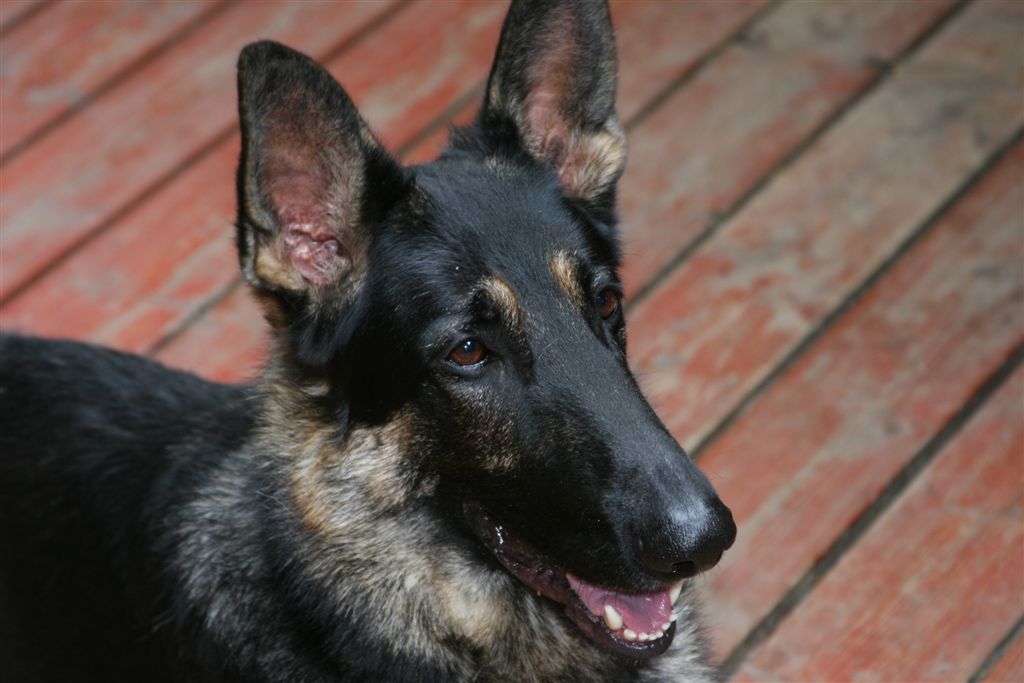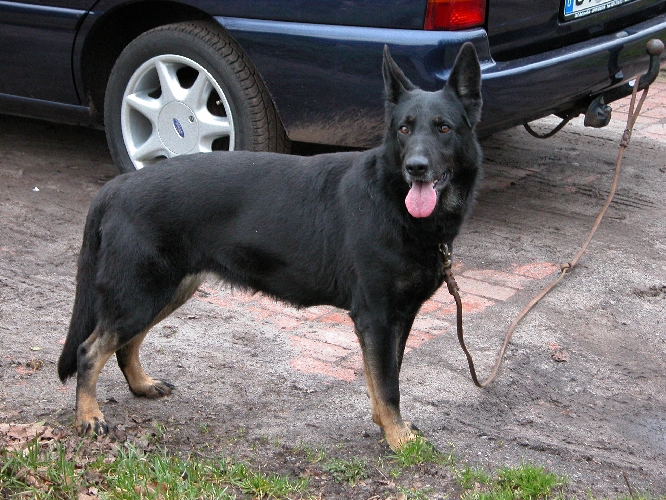
What do German Shepherd Dog judges look for when judging the breed?
By Dennis Fisher.
As someone who has a been a specialist German shepherd Dog for many years, this is a question I have been asked many times especially by people who have only recently become interested in the breed.
What I have always found quite amusing is that they often hope to receive a very short answer of no more than ten sentences!
It is possible to give a brief answer that covers the main features of the breed. But in order to provide useful information for people, seriously interested in the breed, who would like to becoming involved in the Show scene, it will be necessary to go into much greater detail.
Although there issome variation in the methods used by different German Shepherd Judges, especially those living in different parts of the world, there isfar more uniformity now than there used to be some years ago.
Of course the individual preferences of judges and the emphasis they place on certain features will influence their final placings to some extent, but ,generally speaking, present-day German Shepherd Dog judges all over the world adop[t a very similar approach.
WhenGerman Shepherd Dog Judges, enter the show ring andare presented withthe entries,- even before the dogs are required to gait - there is one feature they immediately look. And that is symmetry, correct proportions and balance.
Ever since the first German Shepherd Dog bred by von Stephanitz in Germany and registered in 1899, the emphasis has always been onthe German Sheherd dog'sworking abilities
Because of this, the structure of the dog has been designed to provide the maximum efficiency of movement and the physical characteristics necessary to carry out the work for which it was intended.
This can only be achieved if the dog is well-proportioned and balanced. Only then canwill move in the most efficient manner.
This emphasis on themechancis of movementis a unique feature of the German Shepherd. No other breed attaches as much importance to this as the German Shepherd.
The breed standards of other breeds are largely based onaesthetic requirements and personal interpretation of what constitutes "beauty". The standard of the German Shepherd Dog however, is based, to a very large extent on the concept of "utility"
Because of this, when Judges are presented with a large number of dogs as they enter the Show ring, the most important feature they look for is for balanced proportions.
Even before the dogs are required to start moving and gaiting in the ring, the judges will take a quick glance over all the dogs and immediately form an opinionwith regard to their proportions
TheJudges will cast an eye over all the dogs, as they walk, and make an asessment andwith regard to the balance of their structure and their proportions. Do they posess the correct front angulation and rear angulation as laid down by the standard?
In some ways judging German Shepherd Dogs can be comparedto the judging process in a Mr. Universe or a Miss Universe contest. This may appear to be a ridiculous comparison. But there are definitelycertain similarities.
Even though there are going to be huge variations in the opinions of the Judges in a human contest because of individual preferences; because of national preferences and because there is no such things as written standards,the question of balance, proportions and symmetrynevertheless still play an important role.
To take an exaggeratedly simple example, in a Mr. Universe contest, if the contestant's legs are clearly not as well-developed as the rest of his body, the balance and the symmetry are not going to be as visually attractive and appealing as those of a well-proportioned, well-balanced, symmetrical, athletically built contestant.
This applies equally to a Miss Universe Contest.
In a German Shepherd Dog conformation show, the judge immediately looks for balanced proportions, even while the dogs are standing and certainly while walking.
What are balanced proportions in a German Shepherd Dog? There must be a harmony and balance between the front angulation and the hind angulation as laid down by the standard.
There is a sound practical, mechanical reasons for this not merely based on individual interpretations of aesthetic, but on mechanical considerations.
If the front angulation and the rear angulation of the dog approximates the written standard as nearly as possible., the animals is SHOULD be able to move with the maximum efficiency with the greatest economy of movement.
The word SHOULD has been highlighted for a reason.
Theoretically, the well-balanced dog that presents a beautiful well-balanced picture when standing, should be able to move easily and effortless. But this is not always the case.
Very often once the dog starts to move and gait - as is required by the Judge a softness in back becomes obvious; or the hocks are very loose, and as a result of loose ligaments, or there is insufficient front reach and lack of rear thrust because of weakness of ligaments; or simply lack of condition.
All specialist German Shepherd Dog Judges no matter in which part of the world they are judging - regard movement as the most important aspect in their judging. The dog that is correctly constructed from the point of view of angulation, that also moves with the greatest fluidity and balance, is going to be placed over others that do not able to move as well.
This is the general principles and this is the easiest feature for the novice to recognize. It is comparatively simple for even the novice to recognize a really top quality show specimen.
The dog will stand out and will quite clearly be better balanced that most of the others in the class.
Anyone who has ever attended an important German Shepherd Dog will be aware of this.
As an example, at the annual German National Show for Shepherds, the annual Sieger Show in 2008 and 2009, one dog Vegas du Haut Mansard, was co clearly superior in movement to the others in the Open classes, he was the obvious choice as Grand Championin both years and corned the "Sieger", on both occasions..
It's relatively easy, even for the novice, to recognize an almost faultless dog. Where the difficulty arises is in the judging of dogs that have faults which all dogs have even "Vegas"!
This is where there is a variation in the opinions of even the most experienced judges. This is where there are fairly wide differences in opinions, based on individual emphasis on different features.
Even though the standard lists faults very clearly; and some faults are so serious they are regarded as disqualifying faults, there are such a wide range of minor faults, there is no established ways of weighting the relative importance these faults.
These faults can range of faults such as slightly loose elbows, when the dog is viewed coming towards you; to slight looseness of hocks when the dogs moves away; slight softness of pasterns, ear carriage that is good but not 100% perfect, a croup that is slightly steep and not angled at 23 degrees which is the desired angle as laid down by the standard; a shoulder that is fairly well-angulated butwith an upper-arm that could be a little longer by not as perfect as one wish; an eye that is not quite as dark as it should be; a slight fading in colour.
It is difficult to establish to what degree the dog should be ;enalised because of these faults and whether the minor fault in one dog is as serious as the minor fault in another. How should thisinfluencethe finalplacing of these dogs? .
The Judge is called upon not only to notice these faults, but also to make an individual assessment of how important these minor faults are in comparison with the minor faults of other dogs in the class.
I can recall quite clearly an incident in which I was involved in which my judging was at variance with that of three experienced German judges. The reason for this was because my assessment of the fault shown by dog that I judged was different to theirs.
The incident happened, some years ago, when I was the only non-German invited to a judge a series of four Shows that took place over a long week-end. Three of the others Judges were well-known, highly regarded experienced German judges who judged the first three Shows. I had been invitged to judge the fourth Show.
In the open bitch class that I judge, there was a very beautiful, well-balanced top quality bitch that immediately took my eye. Although she was somewhat over-angulated with a very long stifle, she was quite clearly an excellent animal.
In side gait she was outstanding, with very good forward reach and excellent hind thrust. But when I move the animals away from me I noticed the hocks were so loose, she actually crossed over.
My marshalling steward, who happened to be an all-breed judge, was in the ring with me while I judged. I was very amused at the comment he made as the animal was asked to move way from me. "Goodness, if her hocks were flints she would catch alight!
I knew that the three German judges, who had judged the bitch on previous days, had placed her first. But in all honesty I couldn't bring myself to do so, and I placed her fourth. a relatively good position because it was a very large.
In my opinion, if utility and working ability was to be an important fact in judging, a bitch who moved in this way would tire easily and could not be expected to continue working with the maximum degree of efficiency as an animal with more sound movement.
The German Judges obviously, did not regard the fault as seriously as I had and paid more attention to her pther excellent qualities.
The breeder and owner was obviously very unhappy with my decisions: But years later I felt I was vindicated. Almost every one of this bitch's progeny exhibited this same serious fault of very loose, unsound hocks.
Although there are general principles which all specialist German Shepherd Dogs will adhere to, there are abound to be instances where personal preferences are going to play a part. Especially when it comes to the assessment of faults.
Obviously, the assessment of faults should not be on top of ones agenda in the judging process, and one should not place undue importance to this aspect, but they are factors that should not be ignored.
The questions of a dog's condition is also an important aspect of judging. In many instances an animal that is clearly of absolute top quality does not do as well as expected because towards the end of the extended gaiting the animal flagged and did not display the enthusiasm and drive one would like to see.
This is an aspect of Judging that a number of judged frequently make use of when they are unsure how to place animals.. They insist on continuous gaiting until one anima displays less enthusiasm than the others and this justifies their decision.
One final point with regard to Judging the German Shepherd.
Although it is of the greatest importance to know every feature of the standard, there is nothing that can replace the experienced Judge's ability to use his or her "eye" to assess the quality of the animal This is something that can only come with experience.
The Standard is open to a wide range of different interpretations. If one has to read the written standard that was accepted as the official standard of the German Shepherd Dog many years ago, and compare the written standard as it appears to day, one will notice very little changes.
But if one has to make a point of looking at the top quality winning dogs today and compare them with the top winning dogs of say twenty or thirty years ago, the difference is striking.
But the judging was done according to vitually the same standard!
Obvious it is not the standard itself that is of primary importance but one's interpretation of the standard.
As an exercise make a point of looking at photographs of the German Siegers of recent years, and compare them with photographs of the German Siegers of twenty and thirty years ago,. The difference is striking. This is made even more remarkable when one consider that the written standard was virtually the same as it is today.
You'll find photographs of all the Siegers in recent years and photographs of past Siegerson my website.
Make a point of having a look at these photographs. You'll be amazed at the differences. of . You'll find photographs of the recent top winning dogsand also photographs of the "Siegers" going back to the beginning of the breed.
You'll find these photographs on this website: http://www.allaboutgermanshepherddogs.com and also a wide variety of other articles about the German Shepherd Dog that you'll find of interest.













